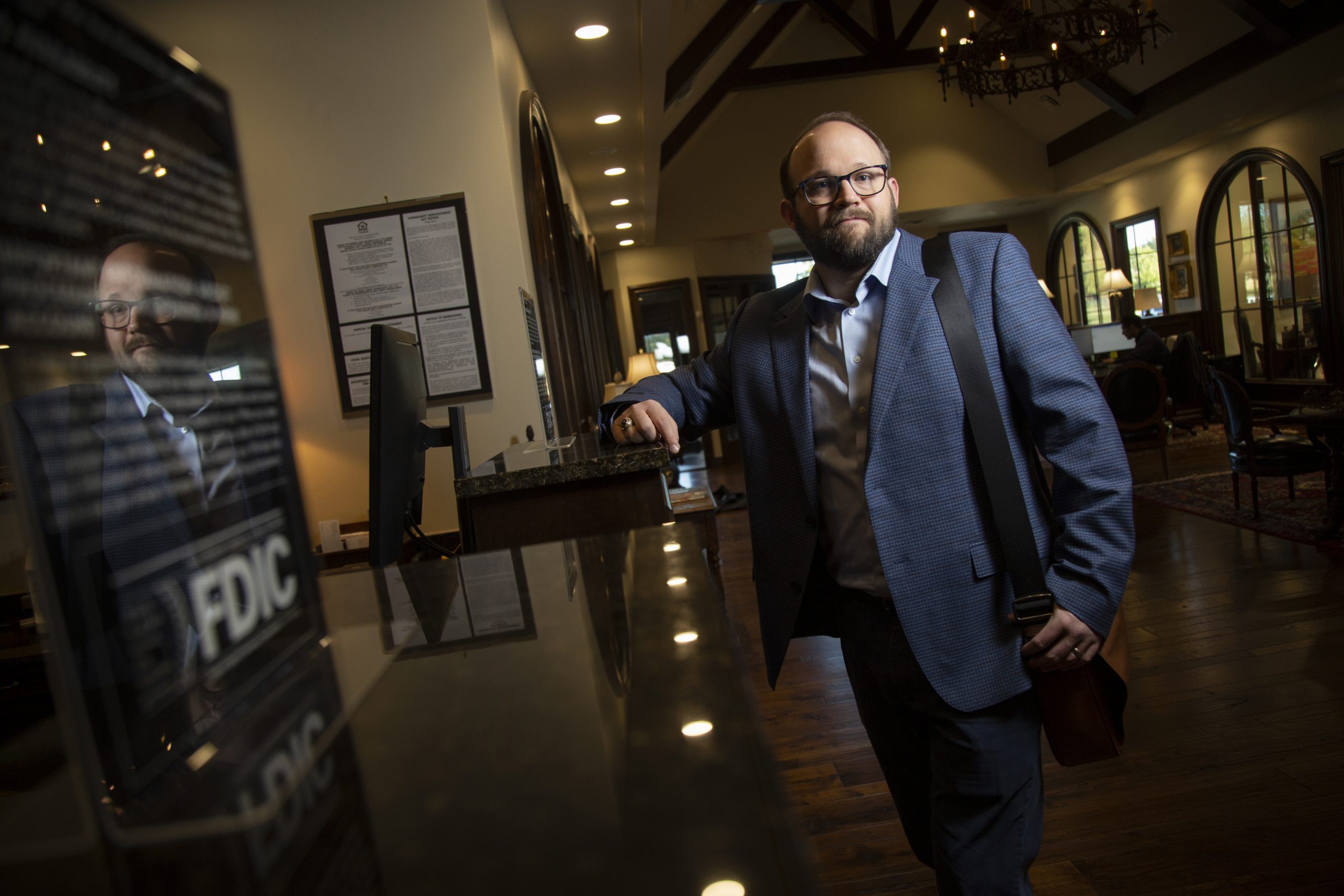Lending Credibility
Stephen Lusch scrutinizes credit unions’ strategies to protect their regulatory advantage over banks.

Stephen Lusch of the Neeley School of Business has found that credit unions strategically manage earnings to stave off political scrutiny over their tax exemption. Photo by Joyce Marshall
Lending Credibility
Stephen Lusch scrutinizes credit unions’ strategies to protect their regulatory advantage over banks.
HIDDEN BEHIND THE KITCHEN TABLE DECISIONS on where to finance a new car or mortgage, there’s deep tension simmering between banks and credit unions that compete to land the business.
Banks have long been leery of the tax exemption that credit unions receive; the debate started almost immediately after the 1934 Federal Credit Union Act, which established the federal credit union system.
The Joint Committee on Taxation estimates the exemption reduced federal revenue by around $2 billion in 2019. The American Bankers Association, in a position statement published on its website, wrote, “The credit union tax exemption is no longer justified.”

Stephen Lusch’s research explores how credit unions protect their tax exemptions. Photo by Joyce Marshall
Credit unions, however, are lobbying to protect their tax exemption, a benefit they insist is being passed on to their customers — since they have no stockholders — in the form of better products and services. Credit unions also can point to Equifax data showing their stronger track record of helping borrowers with lower credit scores, a population historically shunned by banks.
What’s new is a more nuanced understanding of exactly how far credit unions might be going to protect their tax exemption. Stephen Lusch, associate professor of accounting and academic director of Neeley Fellows, a business honors program, published “Credit unions and earnings management to mitigate political scrutiny over tax-exempt status” in the July/August 2022 Journal of Accounting and Public Policy. His research suggests credit unions strategically manage earnings to stave off political scrutiny over their tax exemption.
“Basically, the goal is to try and not make things look as rosy, so you don’t raise as many red flags,” Lusch said, adding that it’s a common accounting strategy in other industries. For instance, Lusch said, when Congress is looking to impose import tariffs, domestic producers often will depress income during those times to paint a picture of inequity, thereby encouraging tariffs on international competitors.
Unlike banks, credit unions are exempt from common reporting requirements, such as the Community Reinvestment Act, which encourages commercial banks to meet the needs of borrowers in low- and moderate- income neighborhoods.
“Notably, tax-exempt credit unions have no reporting mechanism to demonstrate the community benefit they provide,” said Robert Flock, a vice president with the American Bankers Association. “It’s time for Congress to examine whether credit unions’ preferential tax and regulatory treatment is warranted.”
DIVING INTO THE BALANCE SHEETS
Financial institutions are required to account for potential loan defaults and expenses to make sure they are presenting an accurate assessment of their overall financial health. This protective measure, known as a loan loss provision, is an income statement expense set aside to allow for uncollected loans and loan payments.
Lusch and fellow researchers from Drexel University and the University of Arizona wanted to test whether credit unions were using their loan loss provision to appear less profitable.
The researchers focused their inquiry around a key November 2005 House Ways and Means Committee meeting, which was the most recent congressional showdown on credit union tax exemptions. The main agenda item in that meeting was to review whether credit unions were fulfilling the original intent of their tax-exempt status, which is to provide small, unsecured, short-term loans to those without the means to secure loans from traditional financial institutions.
To determine whether credit unions strategically adjusted their earnings in preparation for this important political meeting, Lusch and his team examined quarterly financial reports from 2002 to 2007. Their sample size of 68,747 financial institution observations included 43,847 credit union and 24,900 commercial bank reports.

One tactic used by credit unions in attempting to preserve their tax exemptions is to “to try and not make things look as rosy, so you don’t raise as many red flags,” Stephen Lusch said. Photo by Joyce Marshall
Their research found higher loan loss provision accruals among credit unions relative to commercial banks in the quarters leading up to the congressional hearing, specifically during the 2004 and 2005 calendar years. The credit unions in their research sample overstated the loan loss provisions relative to commercial banks by approximately 2.04 percent of pre-provision earnings per quarter. All told, this led to an estimated understatement of aggregate earnings of $282 million during the calendar years of 2004 and 2005, the research found.
VIEWPOINTS, QUESTIONS TO DEBATE
Mike Schenk, chief economist and deputy chief advocacy officer for policy analysis at the Credit Union National Association, takes issue with the assertions made by Lusch’s research.
“Despite finding only very modest changes, the paper jumps to a fairly shocking conclusion — basically implying that the increases in provisions arose because credit unions collectively conspired to defraud Congress by hiding the industry’s true profitability via a coordinated, multiyear increase in loan loss provisioning leading up to the 2005 hearing,” Schenk said. “To believe this, one arguably needs to also believe that credit union external auditors — who routinely review loss provisioning for reasonableness — were complicit in the scheme, or if not willing participants, that they generally did not recognize this was happening.”
In addition, Schenk said Lusch’s research doesn’t account for the behavioral and cultural differences between credit union and bank leadership.
“Other academic studies characterize credit union leaders as being more risk-averse than banking leaders,” Schenk said. As proof, he compared the higher failure rates in the banking arena to the overall stronger financial positioning of credit unions.
Flock, of the American Bankers Association, said that any financial success credit unions point to comes from an unfair tax advantage that is long overdue for congressional scrutiny.
“It’s been nearly two decades since Congress conducted oversight of the credit union tax exemption,” Flock said. “Since that time, the $2.2 trillion industry has rapidly expanded, with membership now open to most Americans.”
Lusch stands by his research. In class, he gets students to view tax exemptions in terms of trade-offs for reducing tax revenue. He wants students to think critically about whether it’s worth it.
“It’s about understanding the inflows and outflows of tax revenue,” Lusch said. “Where is tax revenue coming from? Where are we spending money through the taxes? Will the benefits received exceed the cost of offering this tax incentive?”
A few more critical questions to ask at the kitchen table.

Your comments are welcome
Comments
Related reading:
Research + Discovery
Rattling the Supply Chain
Tyson Browning studies the unintended consequences of punitive economic actions.
Research + Discovery
Banking on Growth
As Fort Worth continues to expand, Robert Sturns helps attract big business.
Immersed in Exercise
Kinesiologist Robyn Trocchio turns to virtual reality to help people have fun getting fit.